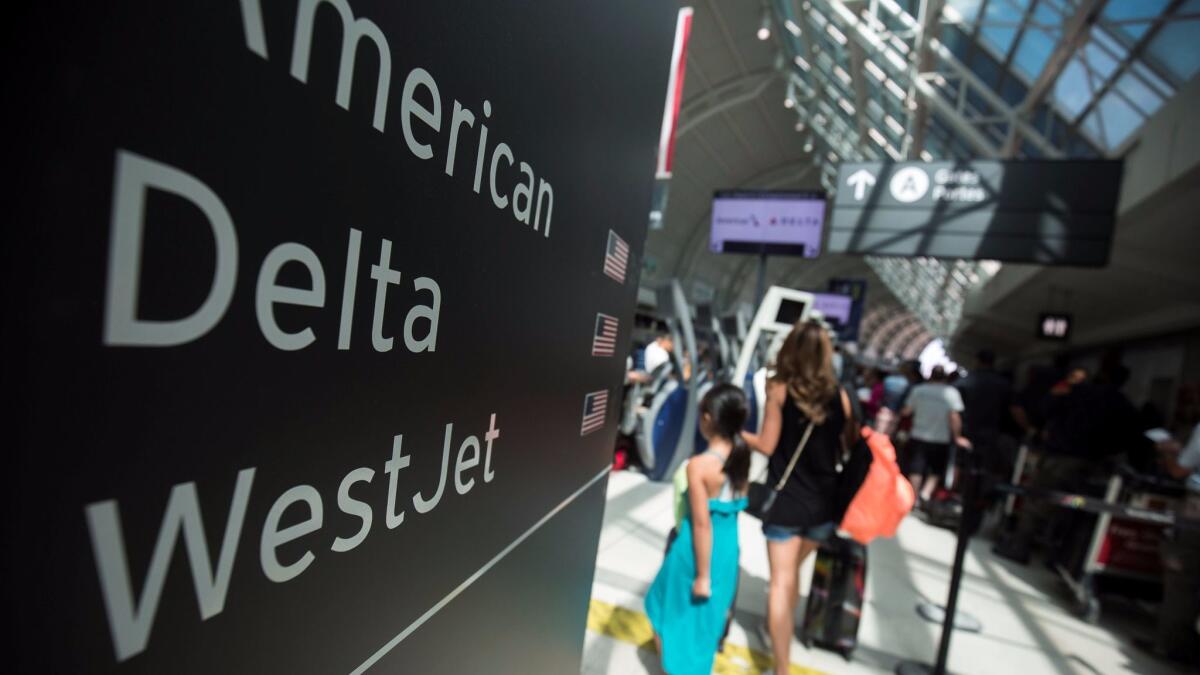You may not be getting the lowest airfare. But don’t blame the website. At least, not for that

- Share via
You may not know that when you search for a low airfare with an online travel agency such as Travelocity or a popular search app such as Hopper, Kayak or FareCompare, you may not be seeing the lowest possible airfares.
In fact, if you use these sites to buy airfare from or to an airport such as Atlanta, where Delta commands more than 80% of the market, or Kansas City, Mo., where Southwest controls 50% of traffic, you may pay more than you should.
But don’t blame the aforementioned websites and apps. Instead, blame the airlines.
Delta and Southwest, which together control about 35% of U.S. domestic seats, are the main players in this airfare drama.
That shouldn’t surprise anyone who knows Southwest’s history. Except for a period on the Easy Sabre search site, a consumer product that existed from 1986 to 1999, Southwest has declined to show its airfares anywhere other than Southwest.com.
But Delta is a relative newcomer to the airfare hide-and-seek game. The Atlanta-based carrier now withholds its airfare data from sites such as TripAdvisor, FareCompare and Hopper, among others.
That means you’re not always getting the full airfare picture, which makes it harder to compare prices.
It’s impossible to calculate how much this is costing consumers who don’t realize what they are not seeing.
But my recent experience suggests the amount could be substantial.
One day, I was searching for a flight between Austin, Texas, and Newark, N.J. On Southwest.com, the dates and flight times I decided on would cost $216 round trip. The least-expensive comparable itinerary (same dates and flight times) on United, which I found using Google Flights, was $763 round trip. Google Flights doesn’t display Southwest fares.
Should the government force airlines to share their data? That depends on your viewpoint.
“We continue to believe that airlines, like all other private businesses, have the right to sell their product where and how they choose,” Vaughn Jennings, spokesman for Airlines for America, the lobbying group for U.S. airlines, told the Minneapolis Star Tribune last month.
The U.S. Department of Transportation is looking into the issue of airlines’ withholding prices from third-party websites and apps, but the airlines aren’t the only entities that do this.
For instance, some hit songs are available only on iTunes. Or, conversely, they may not be on iTunes at all; for years, you’ll recall, the Beatles’ catalog was withheld from Apple’s music service.
Fashion designers such as Marc Anthony can negotiate exclusive marketing deals with retailers such as Kohl’s. Once upon a time, home design guru Martha Stewart sold her products exclusively at Kmart. (She later branched out to J.C. Penney Co. and Macy’s, which ruffled some retailers’ feathers.)
But these examples may be a bit of false equivalence. Consumers probably are not overpaying because of those marketing agreements. (Show me the consumer who has suffered a financial hardship because he or she cannot buy a Louis Vuitton handbag at Target.)
Instead, when online travel agencies can’t display all airfares, they should acknowledge that on their websites.
If you search, say, for an airfare from LAX to Kansas City, Mo., on aggregator Kayak.com, Southwest’s logo appears with a line that says, “Our nonstop flight and low fares only online at Southwest.com.” A link takes you to the carrier’s website.
Most consumers are not airfare search pros. Many understandably assume that when they go to an airfare comparison website or app they will compare all airlines.
Thus the key here is transparency. If those fares aren’t available, the sites should say so. Until all websites do, consumers should beware and be wise.
Twitter: @latimestravel
Sign up for The Wild
We’ll help you find the best places to hike, bike and run, as well as the perfect silent spots for meditation and yoga.
You may occasionally receive promotional content from the Los Angeles Times.



